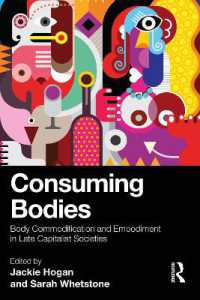- ホーム
- > 洋書
- > 英文書
- > Science / Mathematics
Full Description
Curated by the Fields Institute for Research in Mathematical Sciences from their COVID-19 Math Modelling Seminars, this first in a series of volumes on the mathematics of public health allows readers to access the dominant ideas and techniques being used in this area, while indicating problems for further research. This work brings together experts in mathematical modelling from across Canada and the world, presenting the latest modelling methods as they relate to the COVID-19 pandemic.
A primary aim of this book is to make the content accessible so that researchers share the core methods that may be applied elsewhere. The mathematical theories and technologies in this book can be used to support decision makers on critical issues such as projecting outbreak trajectories, evaluating public health interventions for infection prevention and control, developing optimal strategies to return to a new normal, and designing vaccine candidates and informing mass immunization program.
Topical coverage includes: basic susceptible-exposed-infectious-recovered (SEIR) modelling framework modified and applied to COVID-19 disease transmission dynamics; nearcasting and forecasting for needs of critical medical resources including personal protective equipment (PPE); predicting COVID-19 mortality; evaluating effectiveness of convalescent plasma treatment and the logistic implementation challenges; estimating impact of delays in contact tracing; quantifying heterogeneity in contact mixing and its evaluation with social distancing; modelling point of care diagnostics of COVID-19; and understanding non-reporting and underestimation.
Further, readers will have the opportunity to learn about current modelling methodologies and technologies for emerging infectious disease outbreaks, pandemic mitigation rapid response, and the mathematics behind them. The volume will help the general audience and experts to better understand the important role that mathematics has been playing during this on-going crisis in supporting critical decision-making by governments and public health agencies.
Contents
Diverse local epidemics reveal the distinct effects of population density, demographics, climate, depletion of susceptibles, and intervention in the first wave of COVID-19 in the United States (N. Ashfordi, B. Holder, M. Bahrami, D. Lichtblau).- Describing, modelling and forecasting the spatial and temporal spread of COVID-19 (J. Arino).- A logistic growth model with logistically varying carrying capacity for Covid-19 deaths using data from Ontario, Canada (G. Bucyibaruta, C.B. Dean, E.M. Renouf).- COVID-19 in Ontario (R. Fields, L Humphrey, E.W. Thommes, M.G. Cojocaru).- Sub-epidemic model forecasts during the first wave of the COVID-19 pandemic in the USA and European hotspots (G. Chowell, R. Rothenberg, K. Roosa, A. Tariq, J.M. Hyman, R. Luo).- A Model on the Large Scale Use of Convalescent Plasma to Treat Patients with Severe Symptoms (X. Huo).- Don't wait, re-escalate: delayed action results in longer duration of COVID-19 restrictions (A. Hurford, J. Watmough).- Generalized Additive Models to Capture the Death Rates in Canada COVID-19 (F. Izadi).- Real-time prediction of the end of an epidemic wave (Q. Griette, Z. Liu, P. Magal, R.N. Thompson).- The Effect that Heterogeneity in Social Distancing Has on the Infection Peak (C. McCluskey).- Forecasting PPE Demand for Ontario Acute Care Hospitals During COVID-19 (B. Sander).- Learning COVID-19 Mitigation Strategies using Reinforcement Learning (N. Denis, A. El-Hajj, B Drummond, Y. Abiza, K.C. Gopaluni).- Joint Modeling of Hospitalization and Mortality of Ontario Covid-19 cases (D.Z. Xi).- Evaluating the risk of reopening the border: a case study of Ontario (Canada) to New York (USA) using mathematical modeling (P. Yuan, E. Aruffo, Q. Li, J. Li, Y. Tan, T. Zheng, J. David, N. Ogden, E. Gatov, E. Gournis, S. Collier, B. Sander, G. Fan, J. Heffernan, J. Li, J.D. Kong, J. Arino, J. Belair, J. Watmough, H. Zhu).- Optimal staged reopening schedule based on ICU capacity (K. Nah, M. Chen, A. Asgary, Z. McCarthy, F. Scarabel, Y. Xiao, N.L. Bragazzi, J.M. Heffernan, N.H. Ogden, J.Wu).- Mathematics of the Pandemic (M.R. Murty, V.K. Murty).- A mathematical model for evaluating the impact of non-pharmaceutical interventions on the COVID-19 epidemic in the United Kingdom (H. Zhu).- COVID-19 in Japan (H. Nishiura).








